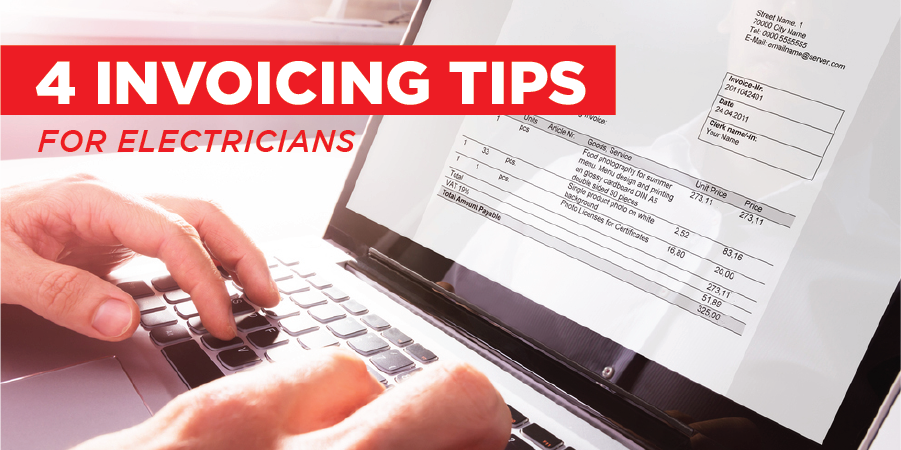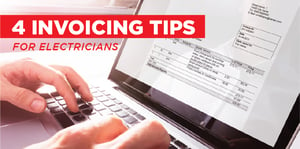
Cash flow is king, especially when it comes to small business. While no one enjoys talking about money, it’s a crucial part of your process and at the end of the day, it’s how you stay afloat. So as an electrician, what’s the best way to invoice your clients and how can you ensure you’re getting paid as quickly as possible?
4 tips for smooth invoicing
1. Set aside time to invoice and check in regularly
Invoicing needs to become part of your weekly, if not daily, routine. Dedicate a couple of hours each day or week (depending on how you schedule your jobs) to sit down and create invoices. As your business grows, the hours you spend invoicing should grow too. A good idea is to create a target for how long after the job is completed, you’d ideally like your invoice to be sent.
For example, every job completed during the week needs to be invoiced by Friday lunchtime or every job needs to be invoiced within 24 hours of completion. This puts a routine in place and ensures you stay on top of your invoicing processes.
If you can, it may be beneficial to automate the process. There are plenty of invoicing systems out there that can create, send and monitor invoices at the click of a button. If you don’t want to automate, create an invoice template that you can use. This ensures the format will always be the same and all the correct information is provided.
2. Set clear payment terms
Payment terms should be set right from the word ‘go’ for any job. Clients need to know the options for payment, how long they have to ensure the payment is made and what debt collection policy you have in place, prior to agreeing to your services. This means you know when to expect payment and they know how long they have to produce the cash.
According to experts, Australians are some of the worst offenders when it comes to paying their bills on time. A good way to get around this is being upfront with customers about your terms and conditions. Another good idea is to shorten your payment terms.
On average, it takes people double as long to pay something than required. This means if you require payment within seven days, it’s going to take two weeks for you to be paid.
By shortening your payment terms, you’re ensuring you will be paid within a reasonable amount of time. In fact, shorter payment terms are becoming the norm, with up to 80% of businesses requesting payment within two weeks or less.
3. Provide different payment options
Make sure your payment options are clear and easy. There’s no denying that people get frustrated with processes that are drawn out or difficult to uphold. If your preferred payment method is credit card, state this upfront in your payment terms.
This is, according to MYOB, the fastest and most effective way to get paid. This isn’t surprising given customers can pay straight away online in just a couple of clicks. However, be open to other payment options as some clients would prefer direct deposit, cash or cheque (yes, it still happens).
Finally, if you really want to be paid as quickly as possible, consider offering incentives. This could be in the form of a discount for early payment.
4. Set up a process for collecting late payments
There’s nothing worse than late payments, especially as you’re trying to balance your books. On top of managing your finances, small business owners may also be relying on certain payments to pay their own bills. This means late payments can have disastrous consequences.
Of course, you need to accept that late payments will occur and you should be building this into your processes. There are, though, some things you can do to chase the payment as quickly and smoothly as possible.
Send email or SMS reminders within a couple of days of the invoice being due. Once the day has passed, you can also send an additional email or SMS. These can even be automated to be sent at regular intervals until the payment has been made. You can also follow up with a phone call.
Sometimes a conversation provides much more insight into why late payment is occurring. You can even offer for the client to pay over the phone or talk to them about a payment plan.
Avoid these 6 invoicing mistakes
There will always be mistakes made along the way. This is simply a part of business. In saying this, however, here are some to avoid:
- Forgetting to invoice – it may sound obvious, but it does happen.
- Not following up on unpaid invoices.
- Sending invoices to the wrong person – ensure the invoice is going to the person who handles the finances. This avoids it getting lost with the middle man.
- Incorrect details – there are certain details that legally need to be on every invoice. Also, ensure each invoice is consistent. Consider using a template.
- Unexplained fees – any additional fees that are included on the invoice need to be explained to the client. No fee should come as a shock.
- Poor formatting – spelling errors or incorrect details are a big no-no.
Are you ready to work with Platinum Electricians?
Want to make sure that your invoices are always perfect and professional? At Platinum Electricians we have a variety of systems, procedures and templates ready for use! Find out more today!


